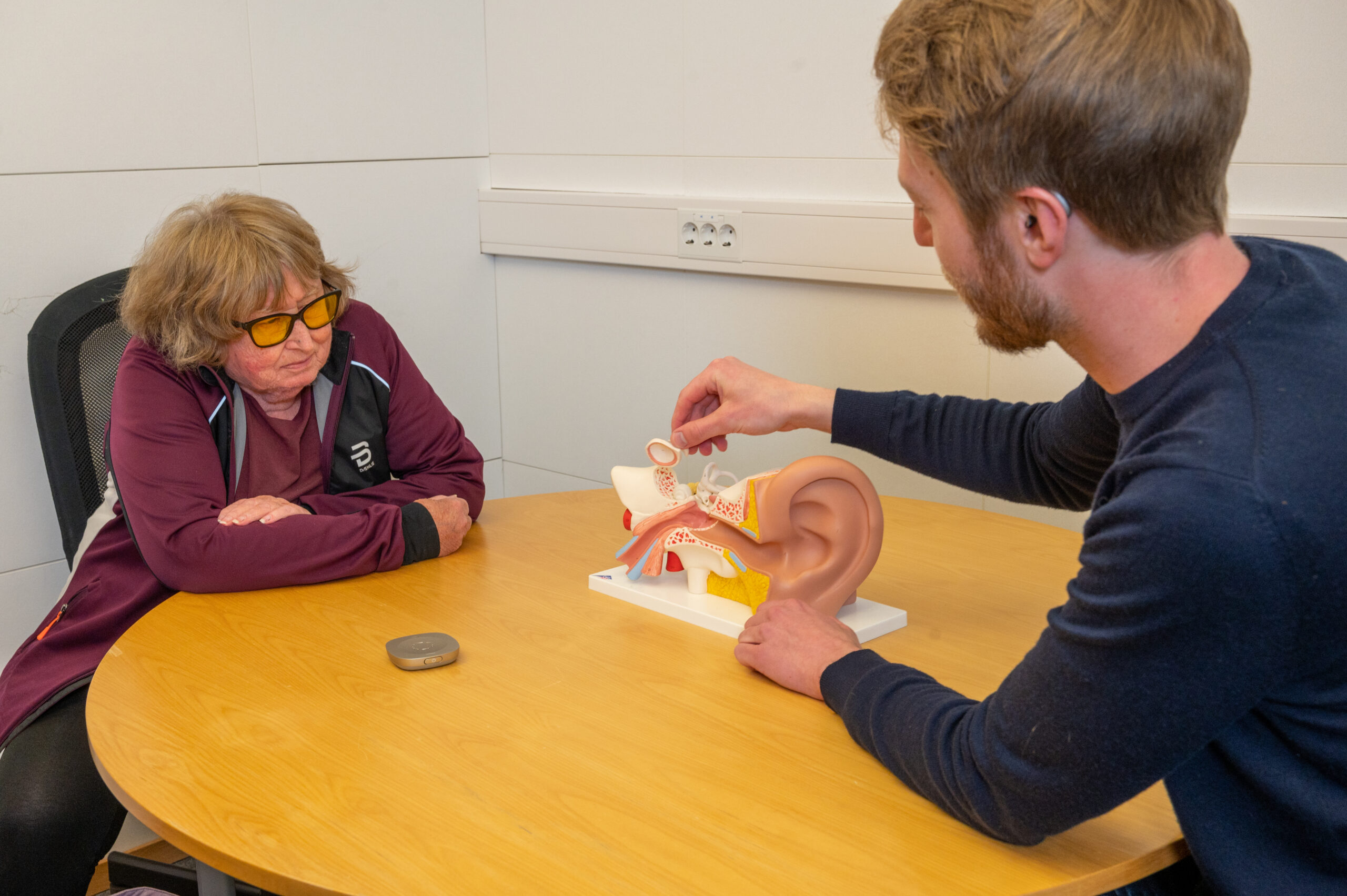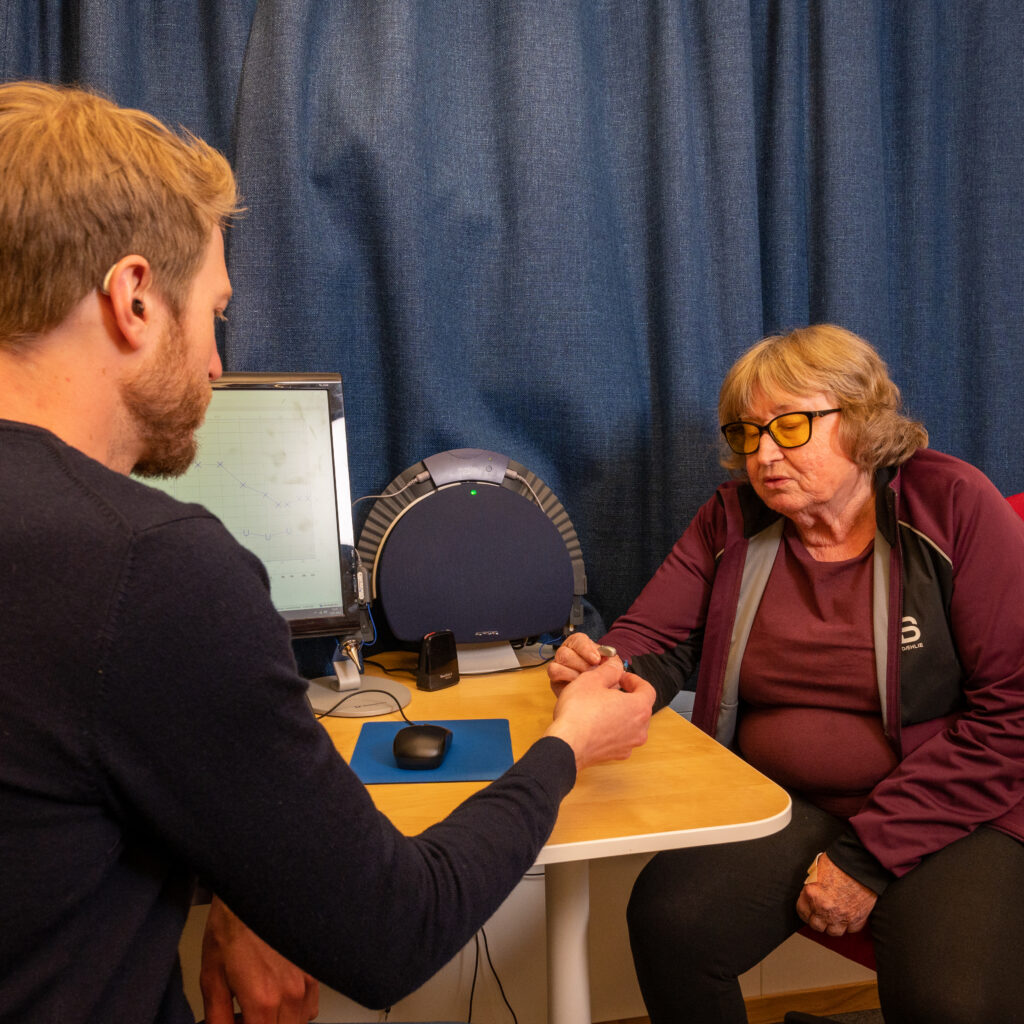- Deafblindness
- Syn
- Hearing
- Mobility
- Communication
- ICT
- Research projects
- Publications
- Conferences and webinars
- Video archive
What is hearing and characteristics of hearing loss?

What is hearing?
Hearing is an important sense of distance that allows us to receive information about our surroundings from a distance. Hearing can be used to communicate with sound and speech, but it can also be used for much more.
Directional hearing makes it possible to detect where a sound is coming from. Hearing detects acoustics and provides information about the room you are in. When there are multiple sounds at the same time, hearing and the brain can choose which sound is interesting and focus on that sound (Dillon, 2012; Gelfand, 2016).
The inner ear is home to the balance organ, which ensures that we keep our balance and know how our head is positioned in relation to the rest of the world (Goplen, 2009). The sense of hearing co-operates with other senses to provide the best possible information. For example, hearing detects a sound and vision examines the sound source.
These are the hallmarks of hearing loss
When you have hearing loss, it's often harder to hear what others are saying. If there is background noise, it will often be even more difficult. Directionality and acoustics can be difficult to understand. Some people find that their hearing loss makes all sounds fainter, while others find that their hearing loss makes sounds unclear, muddy and mumbled. This means that you can hear a voice, but not necessarily hear enough to understand the content of what is being said. This creates communication challenges and can lead to misunderstandings. There are several reasons why you may experience hearing loss. It could be:
- age
- damage
- disease
(World Health Organisation, 2021, pp. 12-29; Dillon, 2012).
When both vision and hearing are impaired
For someone who is already visually impaired, hearing loss will cause more challenges than for people with normal vision. With hearing loss, it's often a challenge to hear what's being said. With both visual and hearing impairment, it's not only difficult to hear bet what is being said, but also who who speaks, and where (Dammeyer, 2014; Dillon, 2012).

If there is a lot of noise, most people will benefit from looking at the speaker. Body language, facial expressions, whether the speaker's mouth is open or closed, and lip reading make it easier to hear what is being said (Peelle & Sommers, 2015). When both vision and hearing are impaired, it is often difficult to understand conversations in noise. This places extra demands on organisation, assistive technology and good strategies.
Read more about visual and hearing impairment here: AV clinic - Eikholt
Hearing aids - a great tool
A hearing aid is an aid, but it does not restore normal hearing (Dillon, 2012). There is a large selection of different types of hearing aids from a wide range of hearing aid manufacturers. In Norway, hearing aids are free of charge. Together, the audiologist and the person with hearing loss choose which hearing aid is right for the individual. You can try several types of hearing aid if necessary (NAV, 2024).
Sources
Sources
Dammeyer, J. (2014). Deafblindness: A review of the literature. Scandinavian Journal of Public Health, 42(7), 554-562. https://doi.org/10.1177/1403494814544399
Dillon, H. (2012). Hearing Aids. Thieme.
Gelfand, S. A. (2016). Essentials of Audiology Thieme.
Goplen, F. (2009). Dizziness - Diagnosis and treatment. http://www.balanselaboratoriet.no/wp-content/uploads/2018/06/Svimmelhet-bok.pdf
NAV (2024). Hearing aid. https://www.nav.no/horeapparat
Peelle, J. E. & Sommers, M. S. (2015). Prediction and constraint in audiovisual speech perception. Cortex, 68, 169-181. https://doi.org/https://doi.org/10.1016/j.cortex.2015.03.006
World Health Organisation (2021). World report on hearing. WHO. https://www.who.int/publications/i/item/9789240020481
Other useful resources:
Read more about laws and regulations on hearing aids here: Hearing aid laws and regulations in Norway - Eikholt
About Eikholt's clinic for combined visual and hearing impairment: Read about Eikholt's vision and hearing clinic
On the NAV Knowledge Bank you will find information about assistive technology and other support for people with hearing loss, as well as other hearing challenges: Hearing | Knowledge Bank
On the NAV Knowledge Bank you will find a description of apps that may be relevant to you with hearing loss; Hearing (app) | Knowledge bank
Do you have questions about combined visual and hearing impairment?
This article was written on 21 May 2024
